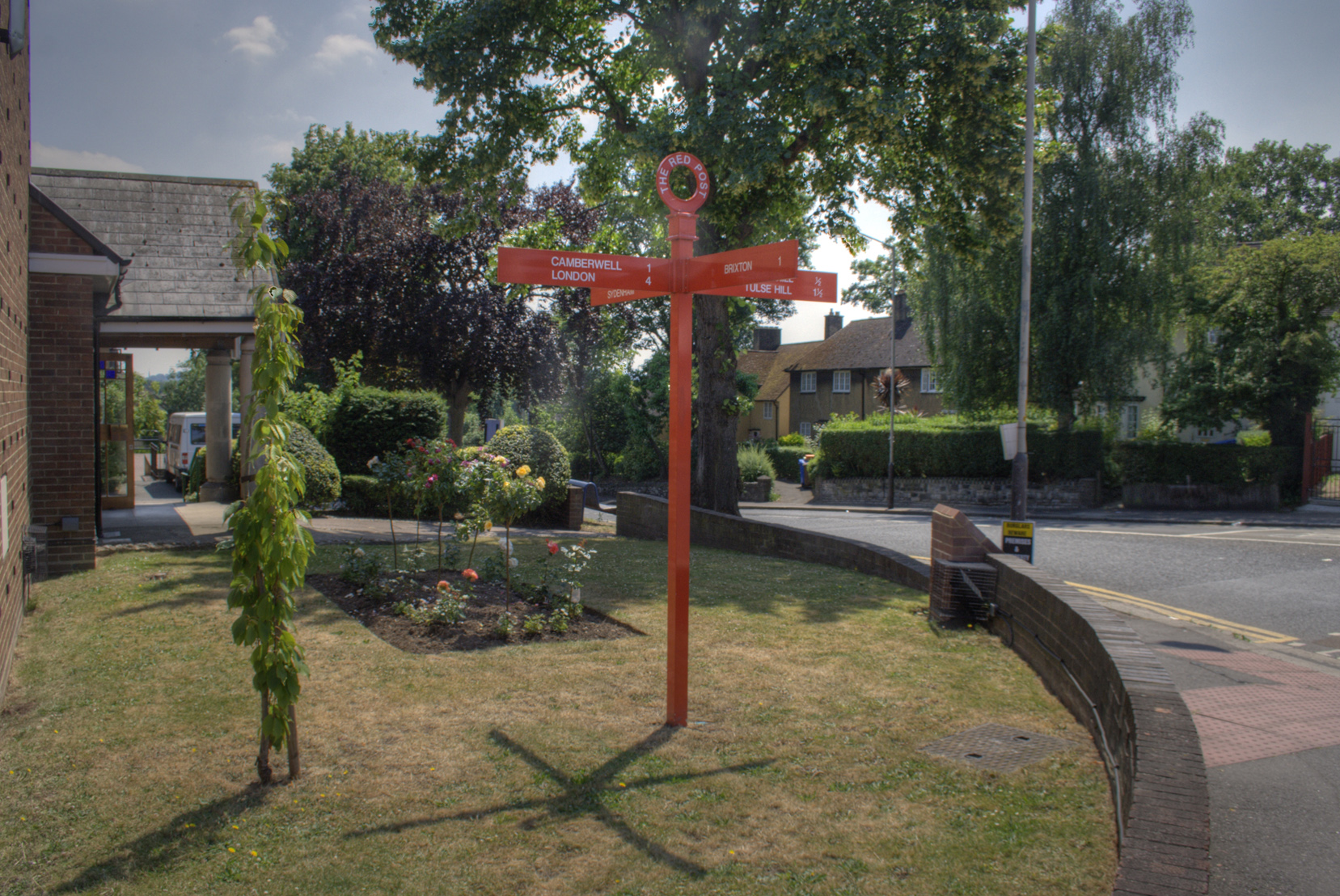There stands atop a hill in London a post, a bright red post. The post is new but recalls an old post that stood here in the past. So memorable was the post that it gave its name to the local road, but probably after the post vanished.
This is the Red Post. It’s in fact, London’s only red post, for a post that is red and has distances upon it, is not just any old post, but a very special sort. Painting a plain ordinary post with red paint won’t do – that is just a post painted red, but this is an actual red post— a post that gains its very meaning from its redness.
Red posts are the early precursors of the normal street signs we see today, and there are a few ancient red posts dotted around the country, but this modern replica is the only one to be found in London.
It’s not entirely sure when the red post arrived at this location[1], heralding distances to local towns, but it is known to have been here in at least 1768. Quite what happened after that is a bit of a mystery.
It is thought to have been here in 1801, and according to one guide to the area[2], was a landmark in 1827, and possibly a bit later, as at around 1830, the road it junction it sat on was renamed in its honour.
Away with Ashpole Road and hello to Red Post Hill.
According to the Dulwich Society[1], the renaming occurred “sometime around 1830”, although I found a Parliamentary Paper[3] published in late 1831 mentioning Red Post Hill in Dulwich, so maybe the renaming took place even earlier than thought?
Presumably from the naming, there is a chance that the post was made from the long-lasting ash tree.
However, a description of the area[4] in 1875 that describes in detail the house on the corner of the road, makes no mention of the post itself. Maybe an oversight, or maybe the post had by then been taken down?
Certainly, it vanished at some point.
Until a modern replacement was erected in October 2010[1].
So there you have it — a modern Red Post, and the only one to exist in London.
2) History and Antiquities of the Parish of Lambeth, etc., Thomas Allen, 1827 Page 400
3) Reports from Coms. on proposed Division of Counties and Boundaries of Boroughs in England and Wales: Parts I.-VIII.
4) Parish of Camberwell. A brief account of the parish of Camberwell, its history and antiquities, William Blanch, Page 392









Growing up in south London (Tulse Hill and Streatham) in the days before telephone numbers dropped the three-letter prefix, I often wondered why some of my friends were on the Redpost exchange. Perhaps you can tell me why our local Streatham exchange was Fountain?
As a child we often passed a red post somewhere in Dorset, possibly on the A35, and I was told it denoted the site of the hangman’s gibbet to display the gruesome remains as a deterrent to would-be highwaymen… have you any idea if that has any truth to it? or merely a long-time urban myth? (like Sweeny Todd)
Trawling around the web finds the story is commonplace, but there is no evidence either way to support or discredit it.
I am sure if someone plotted the remaining red posts and checked archives for gallows locations then it would be fairly simple to prove though.
Well I never knew that and I lived at 92 Red Post Hill from the age of 1 till the age of 22. We lived in what we called ‘The Square’….just down from the traffic lights at the top. The houses there were built from the remains of other houses that were bombed in the war….that’s the reason the windows never fitted, so said my dad. The houses used to be owned by the council but were all bought by the people who rented them.
Just a bit more history….I was born in a large Victorian house (no longer there) hat was situated by the Toll Gate in Dulwich. My dad used to speak to the guy next door, his name was Fred Perry.
Ian,
I am pleased to see the red post has been replaced.i have moved to Dorset in 2009
And have filmed three of the four red posts in the county.they are ten miles apart or ten miles from a town.a good days walk for recalcitrant French pow’s.
We are well west of Portsmouth so I do not think they are to do with London bound prisoners.more possible that they were walked inland from Weymouth or other port.
Prisoners were kept in a barn at the Botany Bay p.h. About 4 miles west of Wimborne. This is all napoleonic era, say 1795-1805.
Your dates seem distinctly earlier. I have no proof,I just do not see other suggestions fitting. I suggested better security for the renewed post on the A35, nine miles from Wimborne.i hope it lasts longer,all the best,James